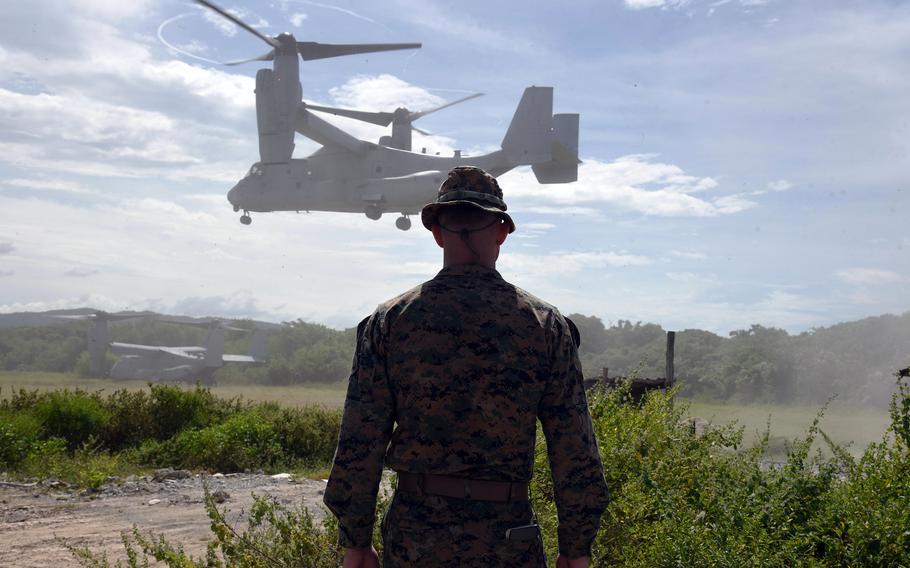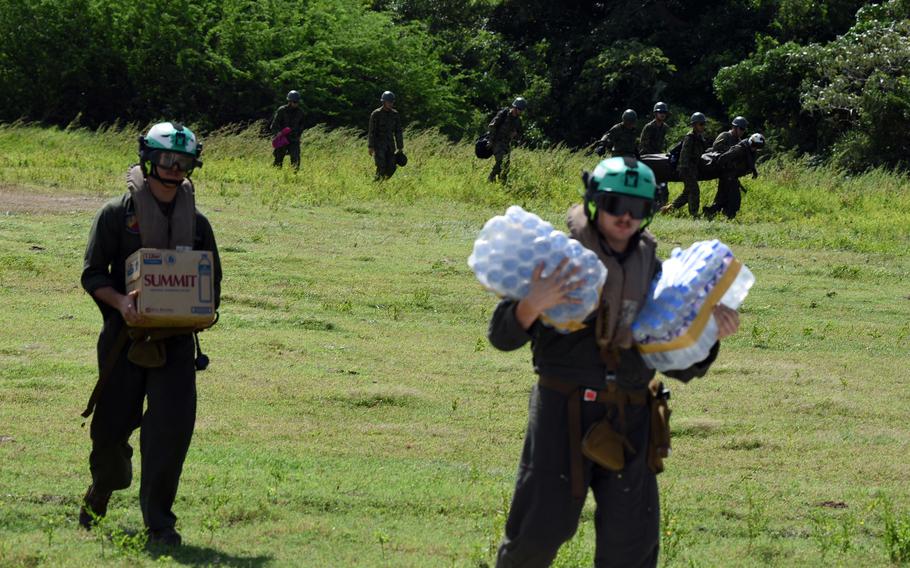
A member of Marine Rotational Force-Southeast Asia watches an MV-22B Osprey land near Camp Cape Bojeador, Philippines, Oct. 20, 2024. (Seth Robson/Stars and Stripes)
CAMP CAPE BOJEADOR, Philippines — U.S. Marines drew on recent real-world experience over the weekend to practice their disaster response skills alongside their Filipino and Japanese allies on a stretch of Philippine coast along the South China Sea.
Filipino and Japanese troops and first responders ferried ashore in small boats Sunday, then worked with U.S. Marines to treat mock casualties and evacuate them aboard a tiltrotor aircraft. The disaster drills took place during the annual Kamandag exercise that began Oct. 15 and ends Friday.
This year’s exercise involves more than 1,000 Marines from the 3-year-old Marine Rotational Force-Southeast Asia and the 15th Marine Expeditionary Unit from Camp Pendleton, Calif.
They’re working with 1,100 Filipino troops and smaller contingents from Japan, South Korea, Australia and Great Britain to practice coastal defense and a range of other skills across the Philippines.
The disaster response training at Camp Cape Bojeador on the northwestern tip of Luzon involved around 30 Marines, 110 Filipino marines and 50 Japanese troops.

U.S. Marines and Japanese and Filipino troops carry disaster relief supplies delivered by MV-22B Ospreys during a Kamandag drill at Camp Cape Bojeador, Philippines, Oct. 20, 2024. (Seth Robson/Stars and Stripes)
Just two weeks prior, Marines of the 15th MEU, embarked on the amphibious assault ship USS Boxer, and the rotational force pitched in to deliver supplies to Filipinos struck Sept. 30 by Super Typhoon Krathon on Sept. 30.
The supplies were staged at Laoag International Airport, just south of the cape, and flown to affected areas farther north.
“Thirty-six hours after being notified we were moving supplies,” Capt. Matthew DeMaso, an air naval gunnery liaison officer with the rotational force, said during Sunday’s training. “That’s how quick we can transition from training to contingencies.”
Part of Sunday’s drill involved a Navy corpsman from the rotational force helping Filipino marines, first responders and troops from Japan’s Amphibious Rapid Deployment Brigade attend to mock casualties.
Role players were assessed for simulated injuries and then evacuated and returned on one of two Marine MV-22 Ospreys from the USS Miguel Keith, an expeditionary mobile base just offshore.
Cape Bojeador faces the expansive South China Sea, the setting for a series of clashes this year between Philippine and Chinese coast guard vessels over disputed territory.
The camp, which includes a medieval-style watchtower, is close to waters where U.S., Philippine and Australian forces sank a decommissioned oil tanker in May during the annual Balikatan exercise. They employed an arsenal, from artillery to missiles and machine gun fire, to sink the tanker, as they would an invasion force.
However, potential adversaries did not figure in the disaster response drill, the Philippine 4th Marine Brigade commander Brig. Gen. Mark Anthony Blanco said after the training.
“We don’t even think about what you have just mentioned during this,” he told a reporter who asked whether tensions between China and Taiwan, due north across the Luzon Strait, overshadow the drill.
The rotational force will remain in the region for six months, according to commander Col. Stuart Glenn.
The force has around 125 Marines in the Philippines this month, but its size will vary depending on the type of training it’s involved in.
The Marines and their Filipino counterparts are focused on readiness, Glenn told reporters after Sunday’s disaster response training.
“We are ready for any crisis or contingency,” he said.